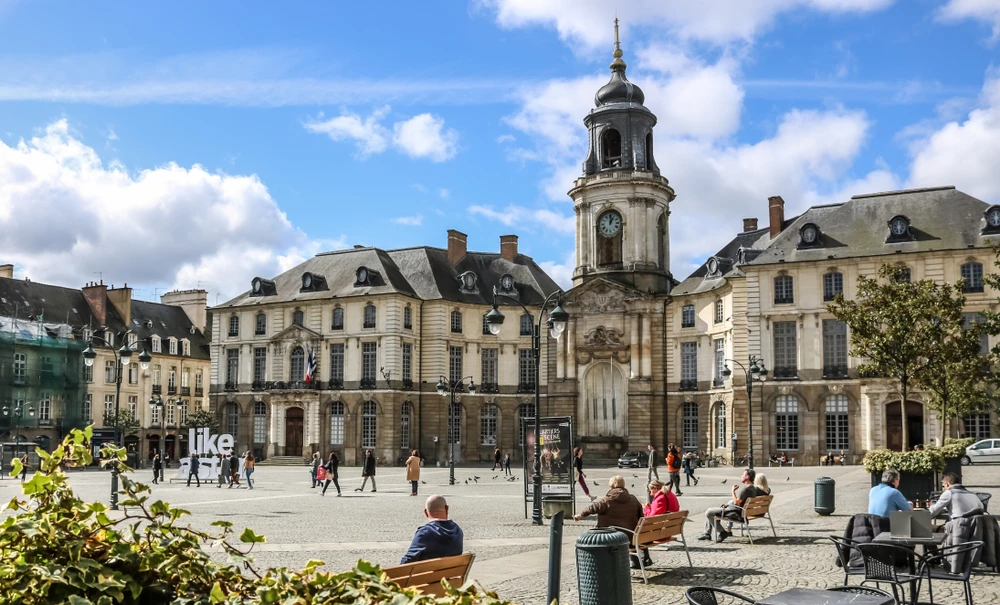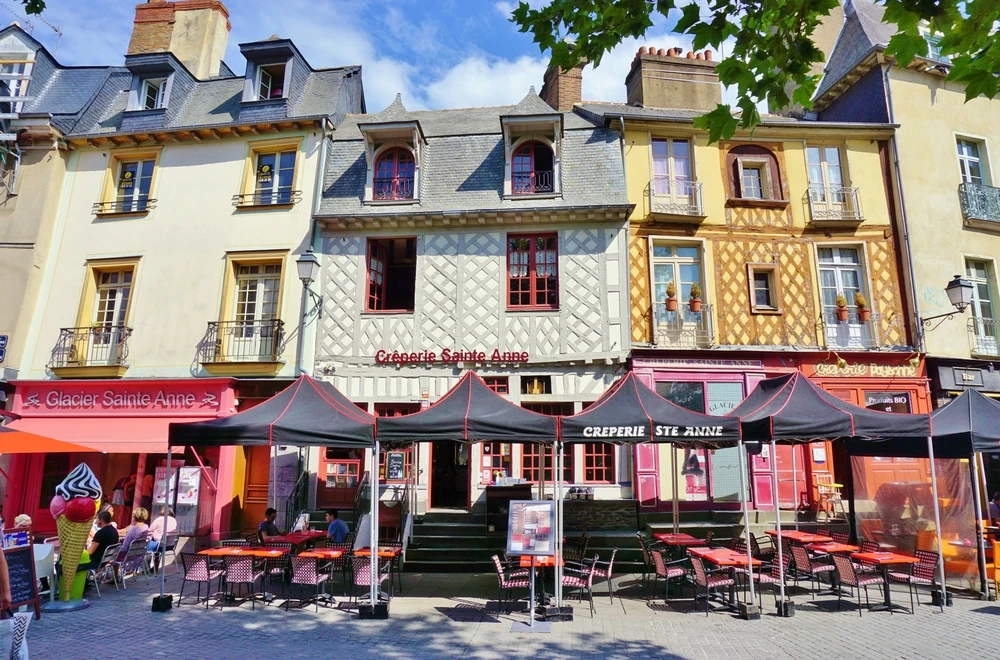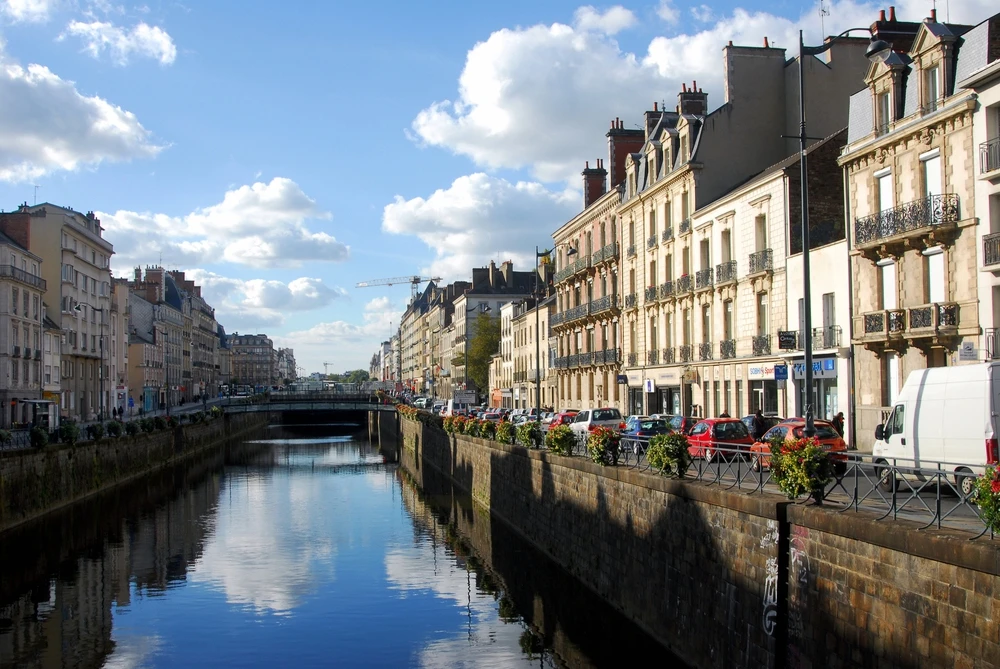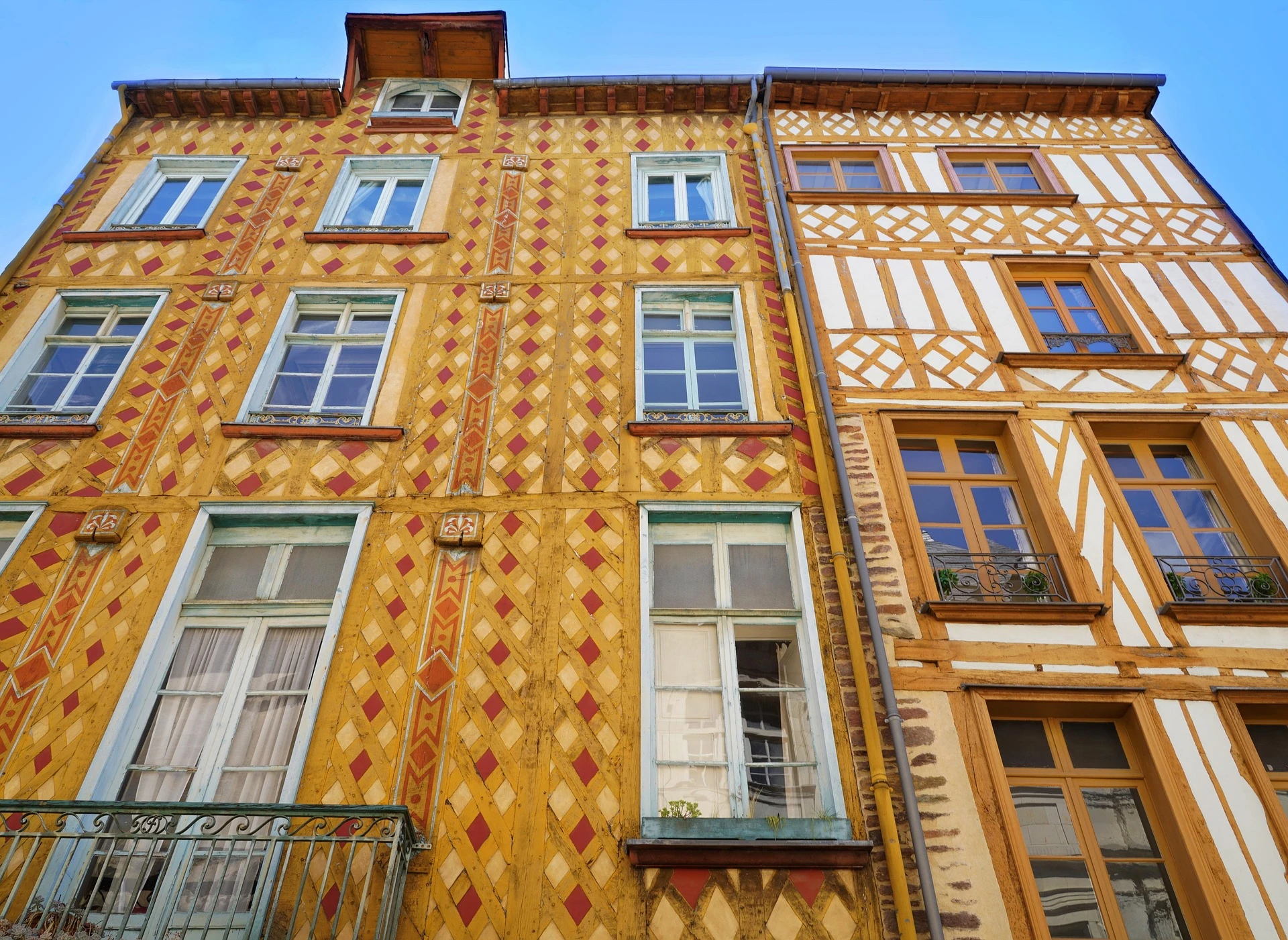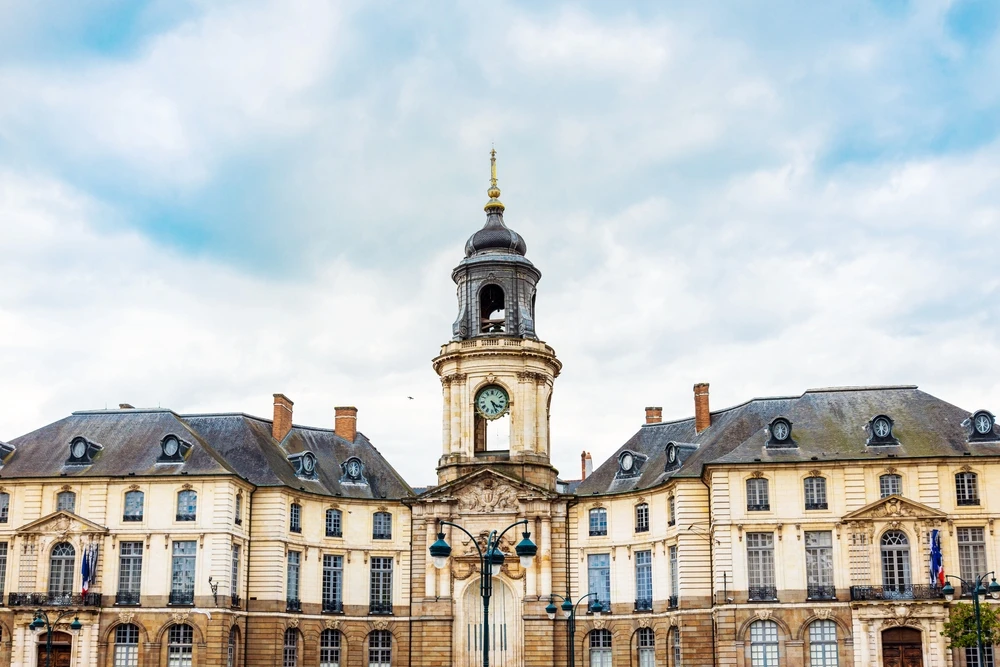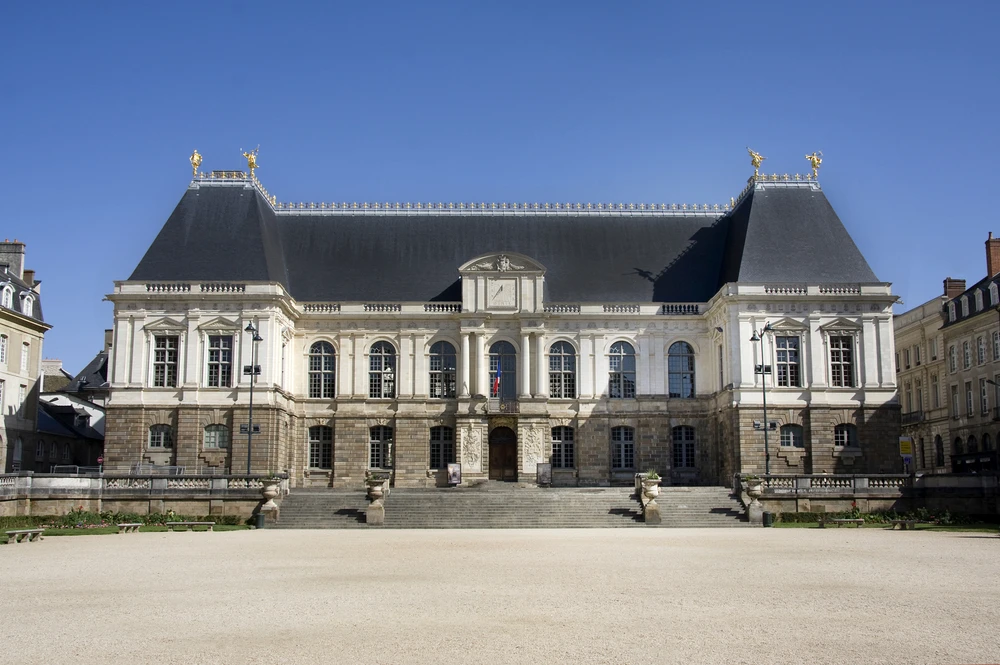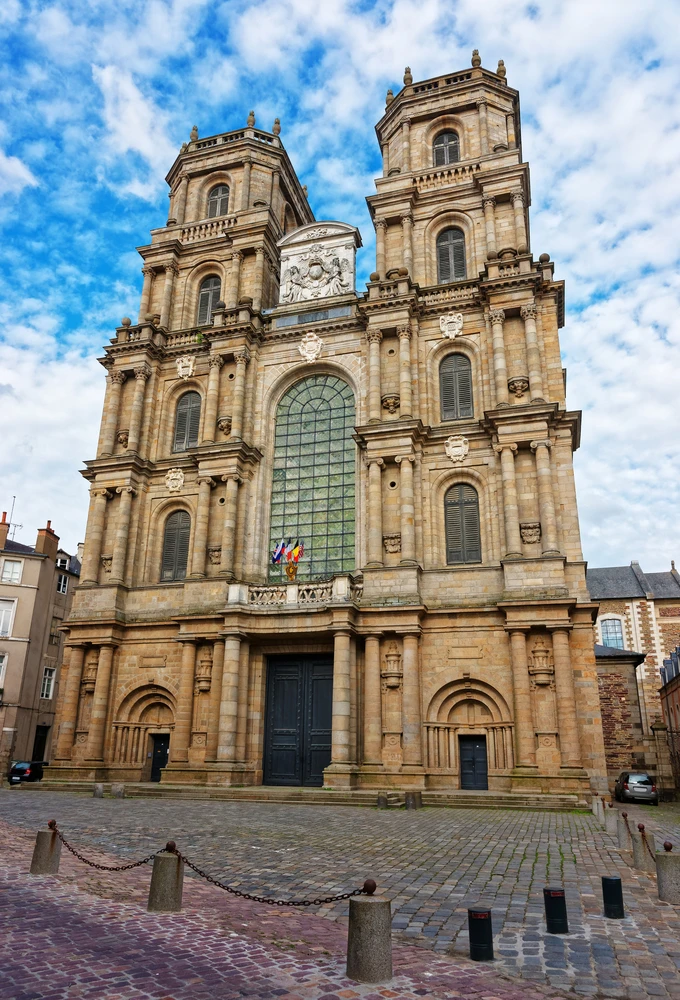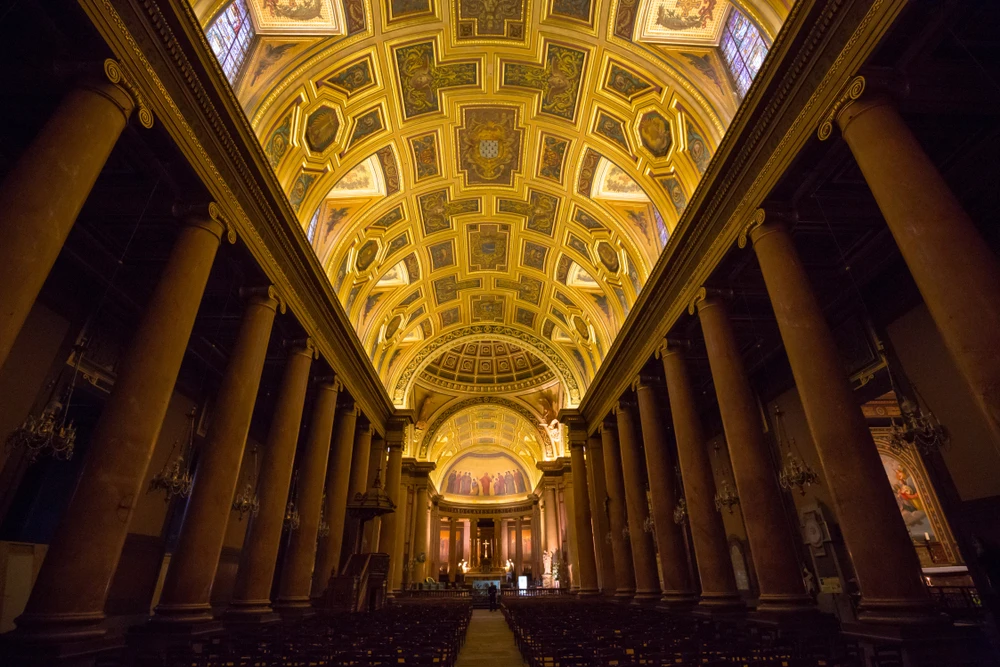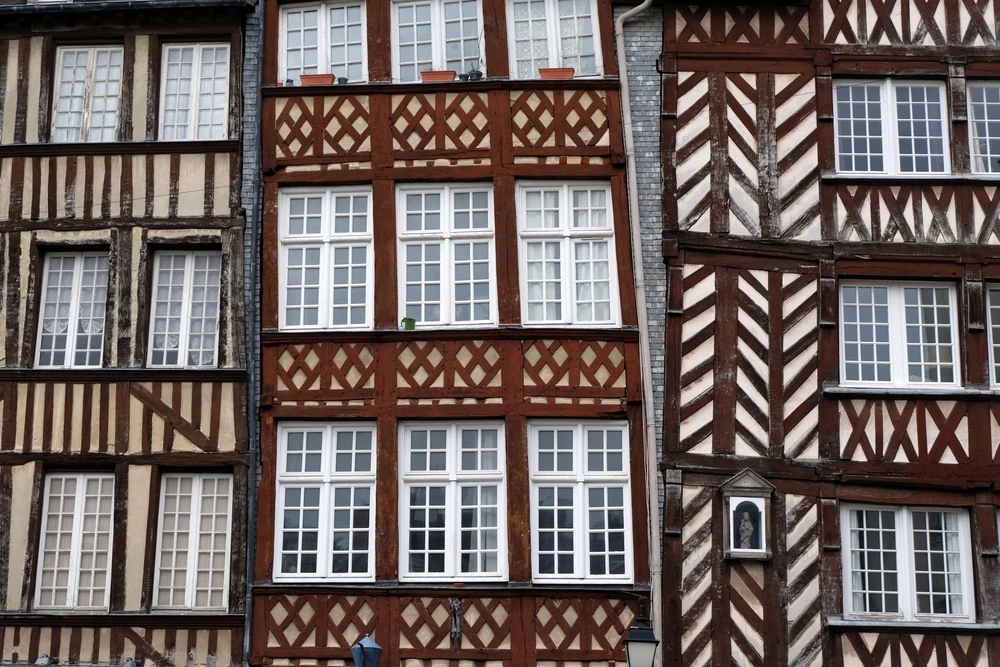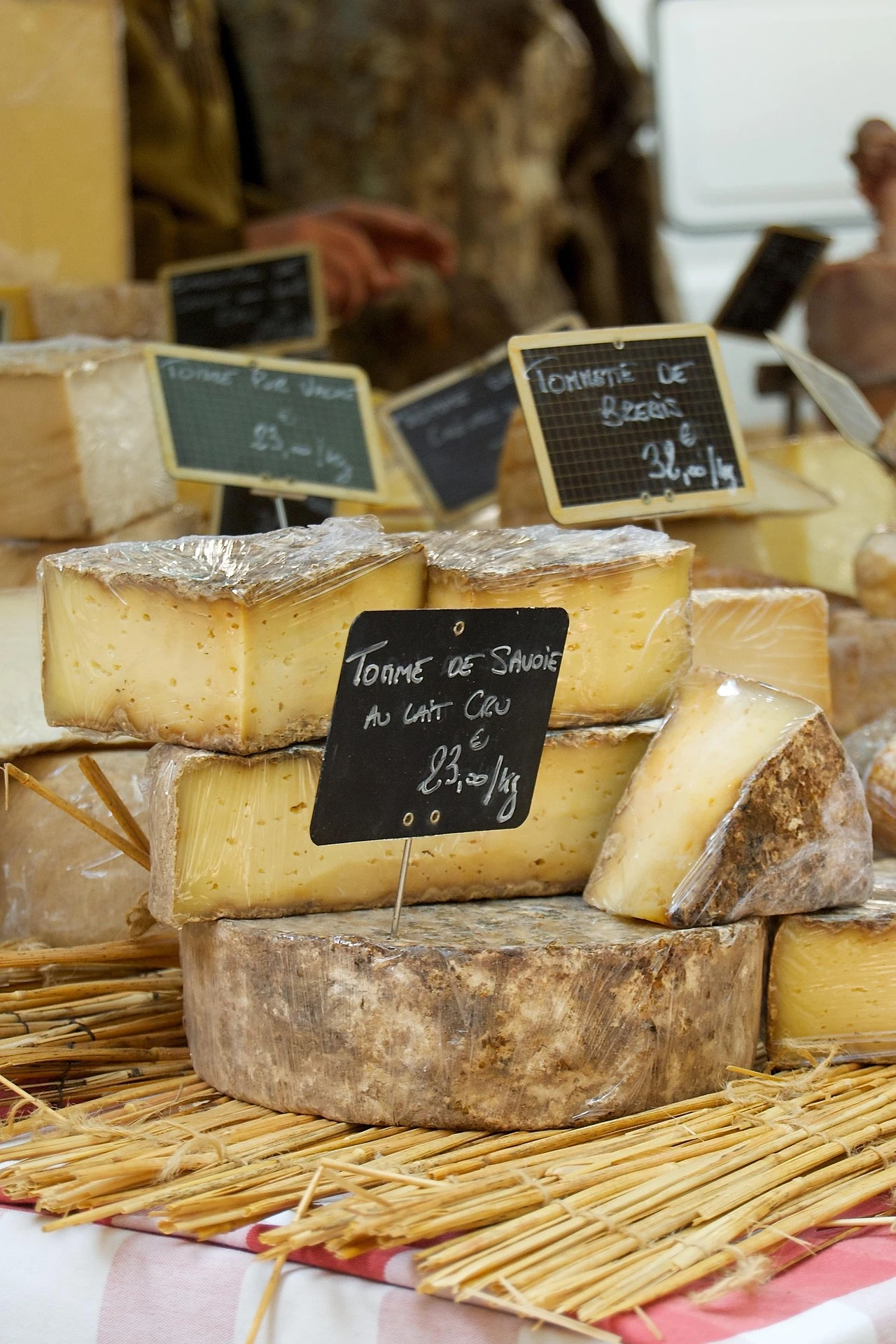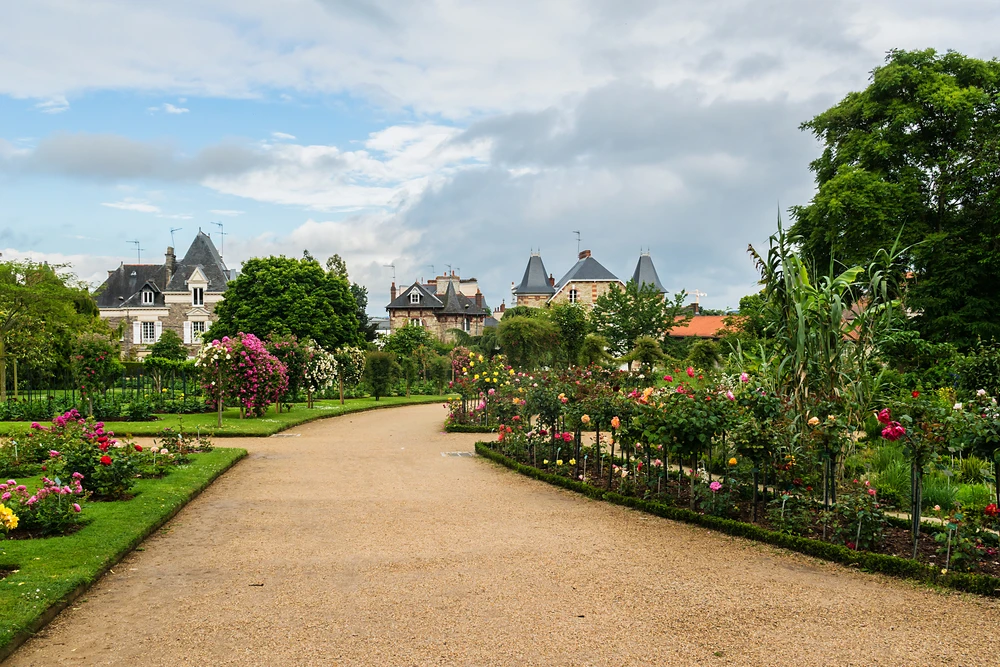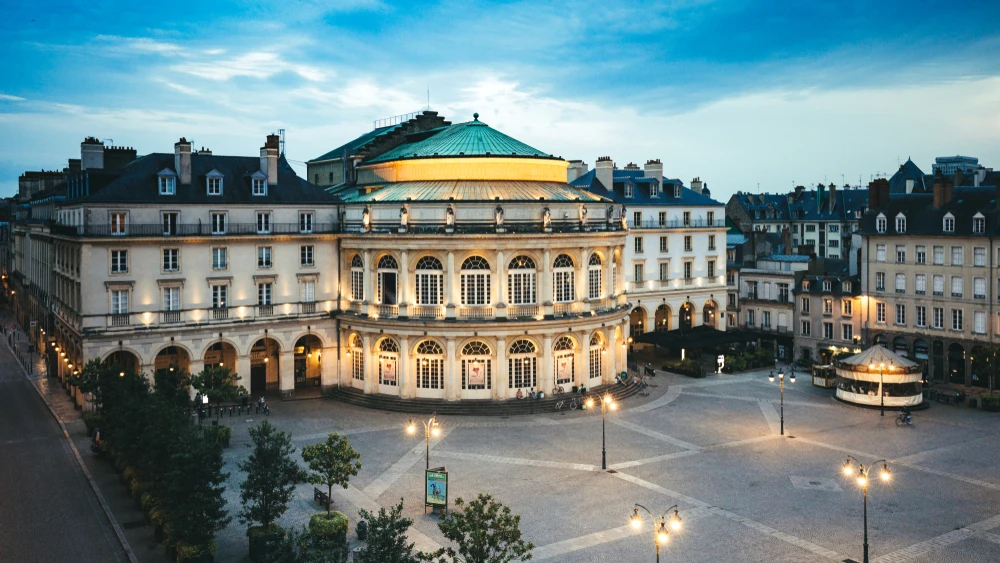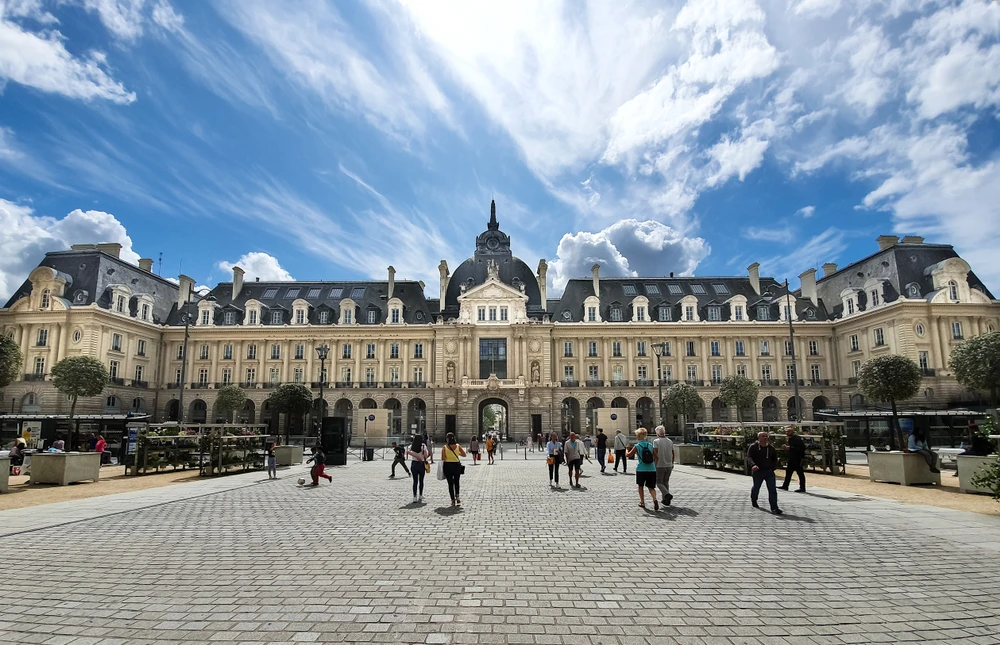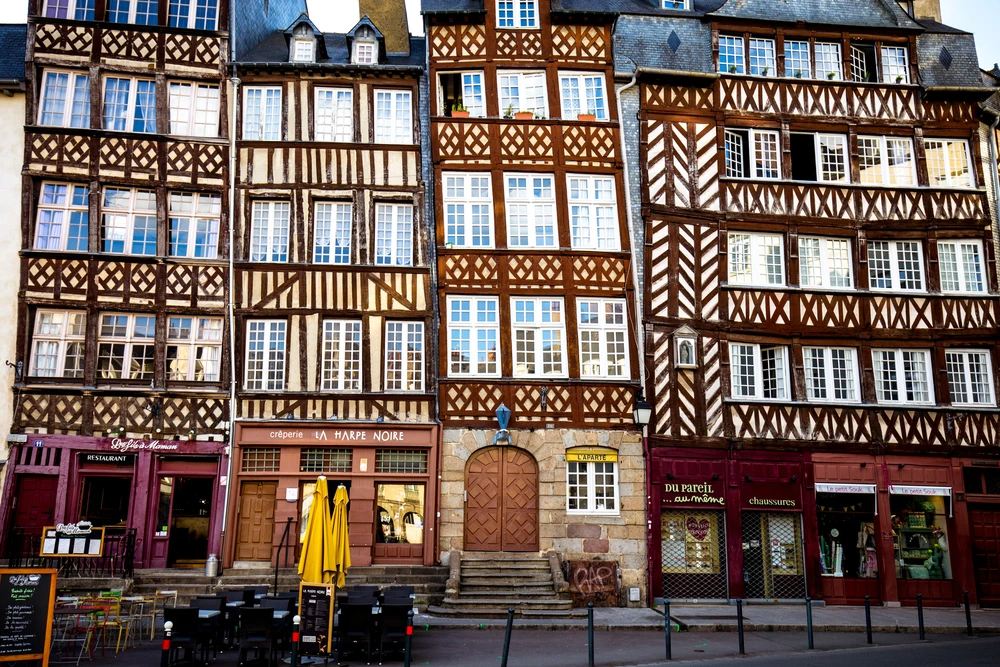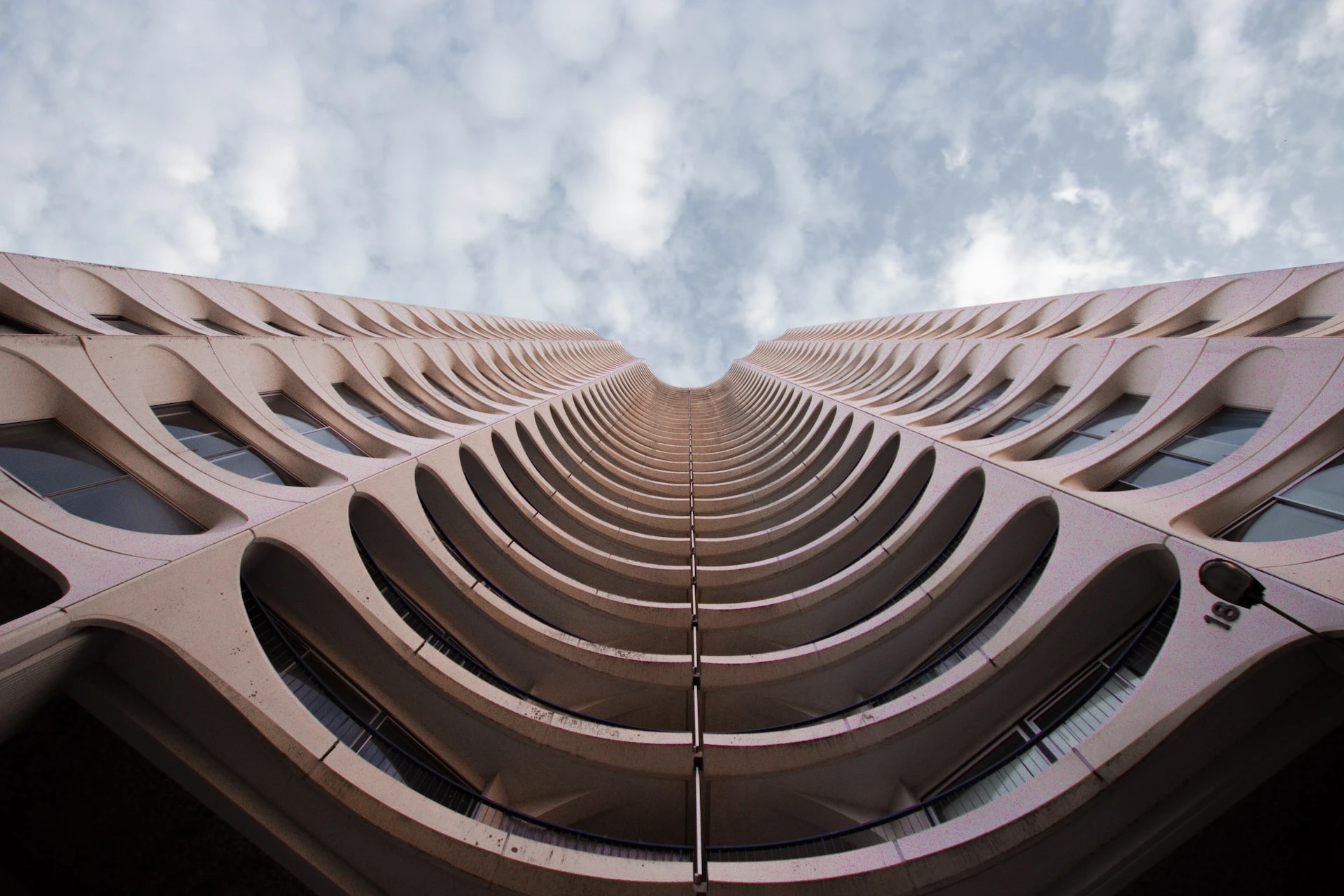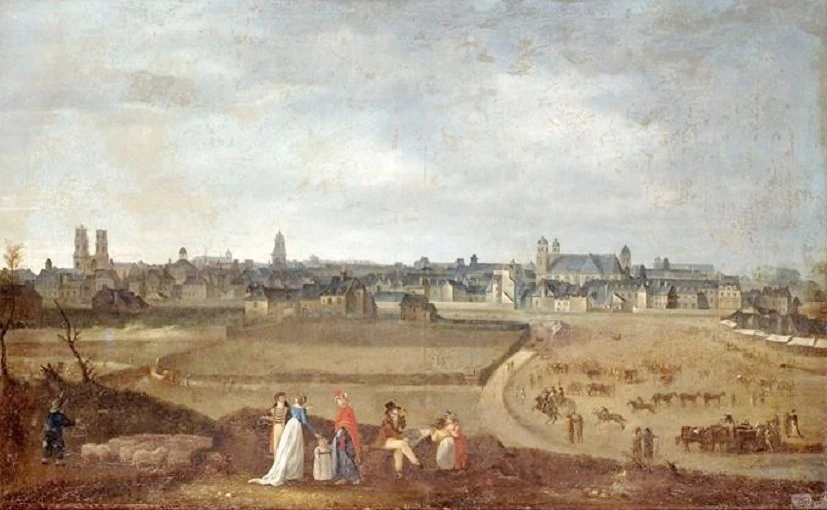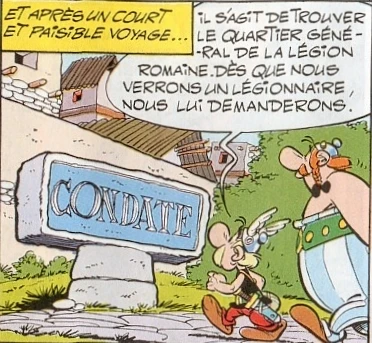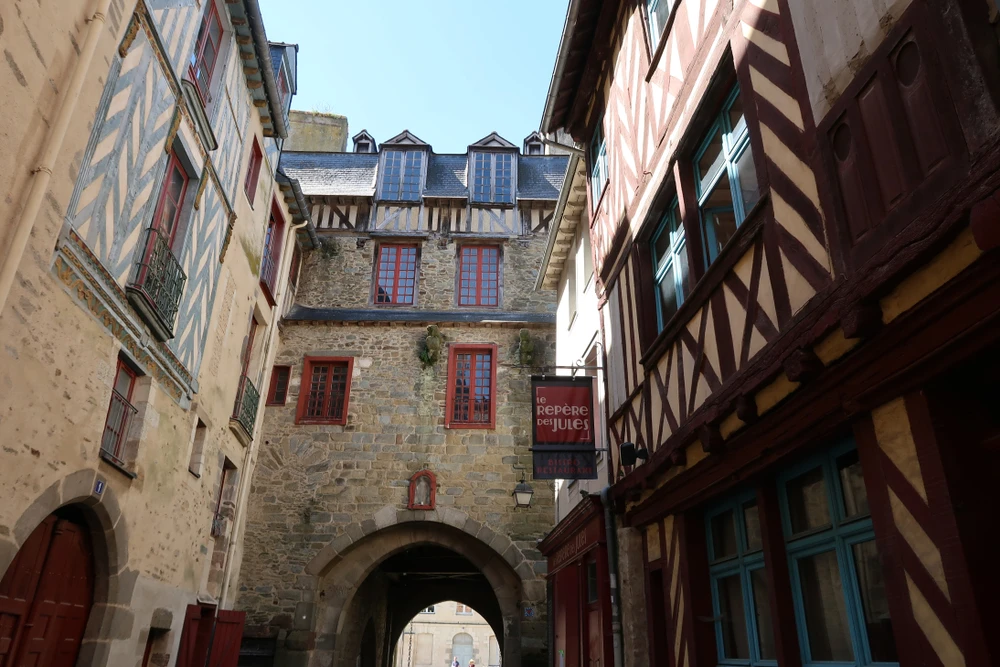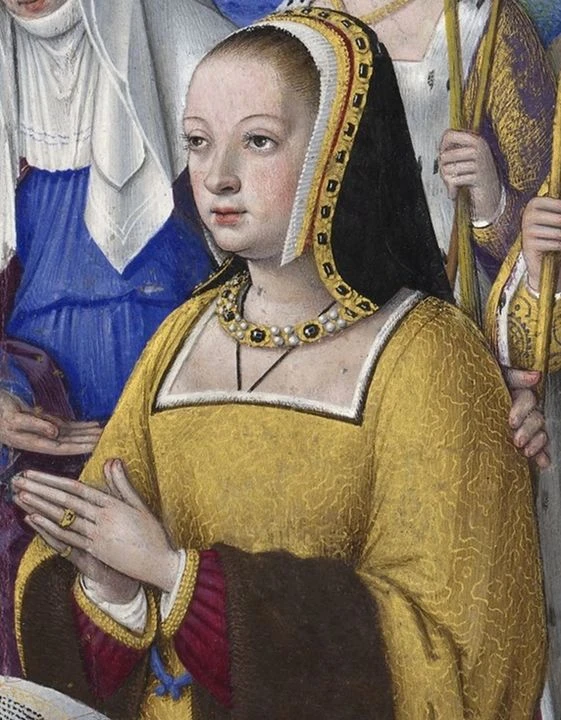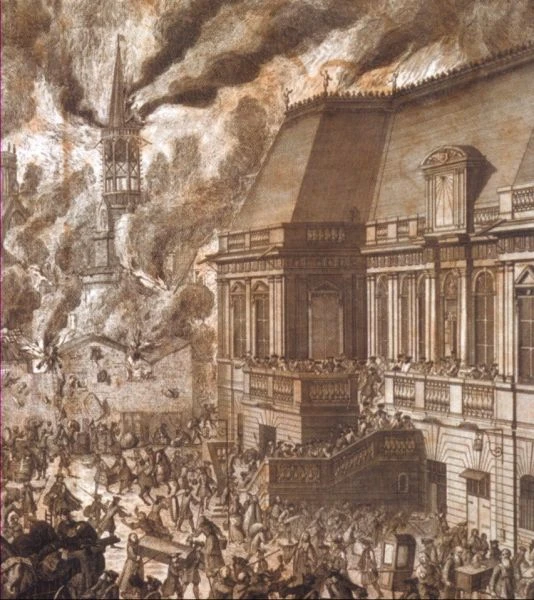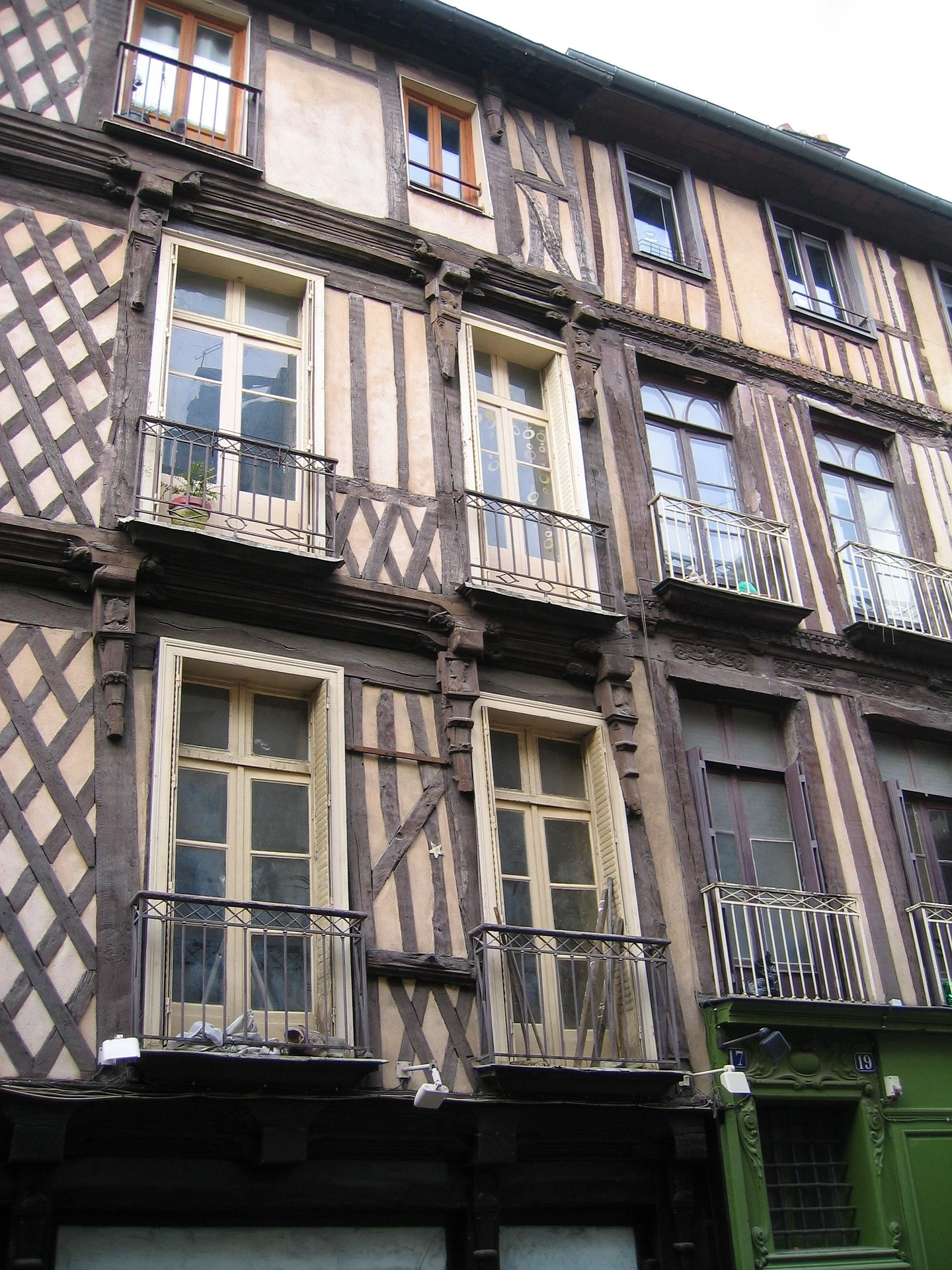Rennes today: architecture, atmosphere and daily life
A town rebuilt after the fire of 1720
Walking around Rennes, it's easy to see why the city exudes architectural harmony. In 1720, a terrible fire destroyed over 900 timber-framed houses. Everything had to be rebuilt, and it was architect Jacques Gabriel who designed a new town, with wide avenues, regular squares and handsome stone buildings. Today, the result of this reconstruction is a homogeneous, elegant city center, with tall houses with granite arcades, but also, in some of the old streets spared by the great fire of the 18th century, a distinctive blend of Medieval and classical Rennes. On the one hand, we admire the colorful, slightly rickety houses of Place Champ-Jacquet, and on the other, the solemnity of Place de la Mairie or the Parlement de Bretagne.
Rennes town hall rebuilt after the great fire of 1720 / Photo by AnnDcs/Shutterstock
Rennes, a lively capital
Rennes isn't just a postcard, it's a city on the move. The capital of Brittany, it concentrates the political institutions, but it's also one of France's biggest student cities. More than 70,000 students live here, and it shows. The cafés, crêperies and bars in the center teem with life, especially in the evenings. The famous rue de la soif (officially rue Saint-Michel) is a mythical spot, with its bars glued together. In fact, Rennes has an incredible number of cafés, bars, brasseries... You'd think you'd never be thirsty again, but this is Brittany, and thirst often returns... A joyful atmosphere that makes even passing visitors smile. A night in Rennes leaves you tired but happy!
Some wooden houses were not destroyed by the great fire of 1720, and are typical of the center and conducive to the installation of many Rennes cafes or restaurants / Photo by EQRoy/Shutterstock
A city that loves conviviality
In Rennes, there's always an opportunity to get together. On Saturday mornings, everyone gathers on the place des Lices, where one of France's biggest markets is held. You can find everything: fresh vegetables, seafood, cheeses, but above all the legendary galette-saucisse, a kind of Breton hot dog eaten on the go. You can't leave without trying it. That's what Rennes is all about: sharing, chatting and laughing over a good local product.
Photo by Michael Discenza on Unsplash
Rennes, a green and pleasant metropolis
Rennes may be a big city, but it's still pleasant to live in thanks to its green spaces. The parc du Thabor is one of the most beautiful in France, blending formal gardens, English parkland and a magnificent rose garden. You'll come across families, joggers, students lying on the grass and tourists looking for a little peace and quiet. The Vilaine, the river that runs through Rennes, has also been given a new lease of life with the development of its banks. Here, you can walk, cycle or simply sit back and watch the city come alive.
Banks of the Vilaine River in Rennes/ Photo chosen by Monsieur de France: depositphotos modesto3
A cultural and festive atmosphere
Rennes also knows how to be cultural capital. Between the Théâtre National de Bretagne, the Opéra de Rennes and the Musée des Beaux-Arts, art lovers are well catered for. But what makes the city's international reputation is the Trans Musicales, the festival that each year reveals talent from all over the world. Add to this a calendar packed with exhibitions, shows and popular events, and you've got a city where there's never a dull moment.
Must-sees in Rennes Must-sees
Rennes Town Hall: symbol and classical architecture
Rennes City Hall. Designed by Gabriel. Center: the belfry / Photo by ilolab/Shutterstock
If there's one monument that sums up Rennes, it's the Hôtel de Ville. Standing on the Place de la Mairie, it was built after the fire of 1720 by Jacques Gabriel, the King's architect. Its majestic facade, central tower and perfect symmetry embody the classical, orderly Rennes. Today, it's a must-see: admire the facade, take photos and enjoy the bustle of the square, especially in the evening when the lighting makes it even more beautiful.
Parliament of Brittany in Rennes: visit and history
The Palais du Parlement de Bretagne. It's still a court of justice / Photo by Jane Rix/Shutterstock
Another emblematic monument is the Parliament de Bretagne. Built in the 17th century, it was long the seat of Breton justice and authority. The interior is spectacular, with its gildings, painted ceilings and ornate woodwork. Devastated by fire in 1994, it has been patiently restored and remains one of the symbols most dear to the people of Rennes. You can visit it and discover its history, making it an absolute must-see.
Saint-Pierre Cathedral in Rennes: a little-known treasure
La cathédrale Saint Pierre de Rennes / Photo by Roman Babakin/Shutterstock
The cathédrale Saint-Pierre often surprises visitors. From the outside, it looks quite sober, but inside, it's an explosion of grandeur: imposing columns, gilded decor, monumental altar. It's a place of meditation, but also a powerful testament to the place of religion in Rennes history.
The interior of Rennes Cathedral/ Photo by Joost Adriaanse/Shutterstock
Half-timbered houses in Rennes: walks and photos
If Rennes is unique, it's also thanks to its medieval timber-framed houses. Some date back to the 15th century and can be found around the place Champ-Jacquet or the place Sainte-Anne. With their colorful facades, sometimes a little leaning, they lend a crazy charm to strolls. They're a favorite with photographers and a must-see if you want to get a feel for the city's medieval side.
Rennes: Place du Champ-Jacquet / Photo by RVillalon/Shutterstock
Place des Lices in Rennes: market and galette-saucisse
On Saturday mornings, the place des Lices is transformed into one of France's biggest markets. More than 300 producers sell their vegetables, fish, seafood, cheeses, and of course the famous galette-saucisse, a true Breton hot dog. You come here as much to buy as to feel the atmosphere: there's chatter, laughter and conviviality.
par David Vives de Pixabay
Parc du Thabor in Rennes: a garden not to be missed
In the heart of the city, the parc du Thabor is a green interlude. Formerly the garden of the Saint-Melaine monks, it combines a French-style garden, an English-style park, a superb roseraie and even an aviary. The people of Rennes come here to stroll, picnic or simply enjoy the sunshine. It's a place adored by locals and a must-see for visitors.
Rennes : Le Thabor / Photo by Kiev.Victor/Shutterstock
Rennes Opera House: architecture and performances
Opposite the Hôtel de Ville, the Opéra de Rennes catches the eye with its elegant circular facade. It's one of the smallest opera houses in France, but also one of the most charming. Even if you're not attending a performance, it's worth admiring from the outside. Its square is a real postcard setting.
L'opéra de Rennes sur la place de la Mairie / Photo by lr.s/Shutterstock
Musée des Beaux-Arts de Rennes: masterpieces to discover
Finally, for a cultural touch, the Musée des Beaux-Arts is an excellent surprise. Here you'll find collections ranging from Antiquity to modern art, with prestigious names like Veronese, Rubens, Chardin or Picasso. It's one of Brittany's richest museums, and well worth a visit.
Must-see walks and districts in Rennes
The Palais du Commerce in Rennes / Photo by 365_visuals/Shutterstock
Old Rennes: medieval streets and half-timbered houses
Getting lost in Vieux Rennes is like leafing through an old history book. Medieval timber-framed houses, often colorful and sometimes leaning, still stand proudly on the place Champ-Jacquet or around the place Sainte-Anne. Looking up, you'll notice the carved beams, narrow windows and these facades that seem to defy time. To stroll here is to smell the perfume of the Middle Ages in a modern capital.
The stunning Place du Champ-Jacquet in Rennes / Photo chosen by Monsieur de France: depositphotos
Quartier des Lices: market, history and life in Rennes
The quartier des Lices is the soul of Rennes. Everything revolves around its large square, which comes alive every Saturday morning with one of the biggest markets in France. Over 300 producers from all over Brittany set up stalls selling fruit, vegetables, oysters, shellfish, cheese, cider and fresh galettes. But the real star is the galette-saucisse, the Breton hot dog that everyone enjoys while strolling. That alone is a monument.
But Les Lices isn't just a market. Historically, it was the place where knights competed in tournaments, hence its name. It was also the place where Rennes' executioner officiated. Around the square, you'll still find aristocratic residences from the 17th and 18th centuries, testimony to Rennes' past wealth. To stroll here is to feel the weight of history, but also the vitality of a city that has kept its traditions.
During the week, the area retains its special atmosphere. The cafés and brasseries surrounding the square welcome residents, students and visitors alike. The terraces are full as soon as the sun appears. People chat, laugh and watch Rennes life go by. On festive evenings, the neighborhood naturally extends to the rue de la Soif, the famous rue Saint-Michel.
Rue de la Soif: "thirst street" a student atmosphere
Naturally linked to Les Lices by the narrow streets in the center, the rue de la Soif is one of Rennes' best-known spots. Its dozens of lined-up bars and crowded terraces give the city a student and festive face. It's an atmosphere unique in France: a mix of conviviality, music and laughter, well into the night.
A city of concerts. In the bars, but also during the famous Transmusicales. Photo by Esther Tuttle on Unsplash
Culture and gastronomy in Rennes: festivals, crêperies and Breton flavours
Rennes, the cultural capital of Brittany
Rennes isn't just a beautiful city, it's also a cultural capital that radiates far beyond Brittany. The Théâtre National de Bretagne (TNB) attracts spectators from all over, the Opéra de Rennes seduces with its charm and varied programming, and the Musée des Beaux-Arts surprises with the richness of its collections, from Antiquity to Picasso. But it's above all its creative spirit that sets Rennes apart. The Trans Musicales festival, held every December, is a veritable institution. Many international artists have made their debuts here. All year round, the city lives to the rhythm of film festivals, street performances, literary rendezvous and contemporary art exhibitions. In short, Rennes is a city that cultivates its energy.
Rennes' crêperies: a living tradition
If Rennes has one culinary pride, it's its crêperies. In medieval alleyways or around lively squares, you'll find them everywhere. You can enjoy the buckwheat pancake, topped with cheese, egg, ham or sausage, always accompanied by a good Breton cider. Then comes the crêpe de froment for dessert: butter-sugar, salted butter caramel or chocolate... Simple, but effective and so convivial. To eat in a crêperie is to enter into the Rennes art of living. The rooms are often warm, with exposed beams and colorful tablecloths. And it's a moment that locals and visitors alike love to share.
Typics of Rennes and Brittany: galettes and crêpes / Photo by Javier Garcia Seijas/Shutterstock
The galette-saucisse: a Rennes institution
The galette-saucisse is well known to the people of Rennes. It's best enjoyed on Saturday mornings at the Lices market. A buckwheat pancake wrapped around a grilled sausage, to be eaten while strolling between the stalls: here's a classic that's part of local life. Not a restaurant dish, it's a popular snack, a symbol of the Saturday rendezvous.
Cider and local beers: the star beverages
A good glass of cider / Photo chosen by monsieurdefrance.com : igorr1 via depositphotos.
In Rennes, people often raise a glass of cidre to accompany a galette. Produced in the surrounding countryside, it can be sweet or brut, but remains the ideal companion for crêperies. Rennes has also seen a real craze for craft beers in recent years. Small local breweries offer blondes, ambers and IPAs that can be found in the city's bars. A perfect complement to Breton tradition with a modern twist.
Gastronomy on the move
While crêpes and galettes are a must, there's much more to Rennes than that. The city also knows how to seduce with its cuisine de la mer: oysters, mussels, scallops and fresh fish arrive daily from nearby coasts. Young chefs are also reinventing Breton cuisine by modernizing it, while highlighting local produce. It's this diversity that makes Rennes' gastronomy so rich.
How to get to Rennes Distances and practical access
La tour des horizons. Detail Photo by Baptiste MG on Unsplash
How to get to Rennes
-
From Paris: TGV direct from Montparnasse in 1h30. By car, about 350 km (3h30 to 4h). Flying is available, but the train is still the most practical.
-
From Nantes: approx. 110 km. TER train in 1h15 or car in 1h30 via the N137. Nantes airport can also be used for an international flight before a transfer.
-
From Saint-Malo: approx. 70 km. TER train in 55 minutes or car in 1h to 1h15. Ideal for combining Rennes and the Breton coast.
-
From London: direct flights to Rennes Bretagne Airport in 1h15. Other option: Eurostar London-Paris then TGV Paris-Rennes in about 5 hours.
Rennes Bretagne airport
The aéroport de Rennes Bretagne welcomes national and international flights. Located just 7 km from the city center, it is connected by bus and cab. There are direct flights from several major European cities, making it a convenient gateway to discover Brittany.
History of Rennes: from ancient city to Breton capital
Rennes in 1800 / illustration chosen by Monsieur de France: Musée des Beaux Arts de Rennes By Jean Loyer - http://www.photo.rmn.fr/cf/htm/CPicZ.aspx?E=2C6NU07ZKNQ3 November 8, 2013, 16:22:30, Public domain, https://commons.wikimedia.org/w/index.php?curid=29491516
Rennes, an ancient city
Condate as seen by Uderzo in "Asterix Legionnaire" / (c) Dargaud editions
Before becoming the capital of Brittany, Rennes was an ancient city. The Romans called it Condate Riedonum, meaning "the confluence of rivers", in reference to the Vilaine and Ille rivers. This was already a strategic position, as it enabled roads and trade to be controlled. Gallo-Roman remains in and around the town bear witness to this founding era.
Medieval Rennes and its timber-framed houses
In the Middle Ages, Rennes was the capital of the Dukes of Brittany, who were crowned there. It became a prosperous trading city. It was during this period that the famous half-timbered houses were built, which still add to the charm of the old center today. The town was also marked by the Dukes of Brittany and conflicts with the kingdom of France. Surrounded by ramparts, it played the role of a regional stronghold.
Les portes mordelaises in Rennes remnants of fortifications. It was in front of this gate that the dukes and duchesses of Brittany dismounted to take an oath to preserve Breton liberties before being crowned in Rennes Cathedral / Photo by Pascal_p10/Shutterstock
During the 2-month siege in 1491, when the King of France wanted to conquer Brittany, the people of Rennes did everything in their power to resist the French onslaught, but it was clear that the city was no match for the powerful armies of the King of France, and Brittany's allies looked the other way. Rennes opens its doors to Charles VIII. It is agreed that Anne will marry Charles VIII, bringing his duchy of Brittany as a dowry. It is said that an engagement is celebrated in the convent of the Jacobins (which still exists, it's become the Palais des congrès). Anne de Bretagne marries Charles VIII in 1491 at Langeais (Indre-et-Loire). Now a widow, she married the successor to her first husband, Louis XII, and was unable to prevent the union of Brittany with France, which became definitive after her death in 1532. She alone has been twice Queen of France in history.
Anne de Bretagne by Jean Bourdichon, detail of a miniature from Les Grandes Heures d'Anne de Bretagne, circa 1503-1508, BNF
Rennes and the fire of 1720
The event that shaped the face of Rennes today was the fire of 1720. In six days, it destroyed nearly 900 half-timbered houses and forced a complete rethink of urban planning. The king entrusted reconstruction to Jacques Gabriel, architect of Versailles, who redesigned the town with wide streets, regular squares and stone buildings. This led to the creation of Place de la Mairie and Hôtel de Ville, symbols of the new classical Rennes.
The fire of 1720 ravaged 40% of the city but did not destroy the Parlement de Bretagne / by Jean-François Huguet - [1] but above all Collections numérisées des Champs Libres
Rennes in the 19th and 20th centuries
In the 19th century, Rennes continued to grow. The arrival of the railroad in 1857 brought the city closer to Paris and encouraged its economic development. In the 20th century, Rennes became a major university and industrial city. The arrival of the Citroën factory, followed by the creation of business and research parks, attracted large numbers of residents and led to an explosion in the city's population.
Rennes today: a student and scientific city
Rennes is first and foremost a big student city: with over 70,000 students, two universities, Sciences Po, INSA, CentraleSupélec and ENS Rennes, it ranks among France's most dynamic university towns. But the Breton capital is also a recognized research hub: home to Inria, INRAE, Orange Labs and numerous laboratories in the fields of digital technology, cybersecurity, health and telecommunications. This dual student and scientific identity makes Rennes a modern, innovative and lively metropolis all year round.
FAQ about Rennes: frequently asked questions
How long does it take to visit Rennes?
You can discover the essentials of Rennes in one weekend: the Parliament, Hôtel de Ville, Parc du Thabor, timber-framed houses and the Lices market. If you stay 3 to 4 days, you'll also have time to explore the museums and more modern districts.
What to do in Rennes when it rains?
If it rains (and it does in Brittany!), no worries. You can take refuge in the Musée des Beaux-Arts, visit the Parliament de Bretagne or discover the Théâtre National de Bretagne. The crêperies and cafés in the center are also perfect for taking shelter while enjoying Rennes' art de vivre.
Is Rennes easy to visit on foot?
Yes, Rennes is a city on a human scale. Most of the must-sees are concentrated in the historic center, and everything can be covered on foot. The metro and buses are the perfect complement for going a little further afield.
What are the typical dishes to try in Rennes?
It's impossible to leave without sampling the galette-saucisse from the Lices market and stopping by a crêperie to enjoy buckwheat galettes and wheat crêpes, accompanied by a cidre breton. Seafood, from the nearby coast, is also a sure bet.
par Ludovic Celle from Pixabay
Are there any free activities in Rennes?
Yes, several! Stroll through the parc du Thabor, stroll through the Vieux Rennes with its half-timbered houses, or visit some of the museums on free days. Rennes offers plenty of accessible pleasures without spending a dime.
Where best to stay in Rennes?
The best place to stay is in the centre historique, near Place Sainte-Anne or Les Lices. Here, you're just a stone's throw from monuments, restaurants and bars. For a quieter stay, the neighborhoods near Le Thabor are also very pleasant.
Getting around Rennes
The center is within walking distance, but Rennes also has a modern metro (line A and line B) and an efficient bus network. Self-service bicycles also make getting around easy. The airport and TGV station put Rennes less than two hours from Paris and London.
What are the opening hours of the Lices market?
The Lices market takes place every Saturday morning, from around 7:30am to 1:30pm. It's one of the biggest in France, and attracts locals and visitors alike.
Practical information – Rennes
Practical information – Rennes
Access / How to get there
Rennes is easily accessible from Paris, with a journey time of around 1 hour 25 minutes by TGV from Montparnasse station. By car, allow 4 hours via the A11 and then the A81, and around 1 hour 15 minutes from Nantes via the N137 or 1 hour from Saint-Malo. Rennes–Bretagne Airport, located 7 km from the city center, offers direct flights to Lyon, Marseille, Nice, Toulouse, and several European capitals. The modern, centrally located SNCF train station provides easy access to the historic center on foot or by metro.
Prices and visiting tips
The municipal museums are free on the first Sunday of the month. The Musée des Beaux-Arts and the Musée de Bretagne generally cost between €6 and €8. Guided tours from the Tourist Office are available from €10 depending on the theme (historical tour, street art, night tour, etc.). The Marché des Lices, one of the most famous markets in France, is held every Saturday morning. To avoid queues at museums or temporary exhibitions, it is advisable to book your tickets online, especially during holidays and weekends.
Useful contacts
Rennes Tourist Office
1 rue Saint-Malo, 35000 Rennes
Phone: +33 (0)2 99 67 11 11
Email: contact@tourisme-rennes.com
Official website: https://www.tourisme-rennes.com

